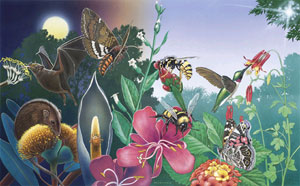It's almost spring: time for sultry nights, birds, bees, renewal and the sweet promise of new love.
 For us humans, that might mean flirty skirts, a new perfume, a dapper new hat or hip hair cut, all in the hopes of attracting a new, or very old and loyal, perfect mate. Plants also feel the call of spring and respond. They too show off their brightest colors, excrete their most seductive scents and attempt to lure a mate. Of course, plants can't move (very quickly), so they hire a pollinating partner, and pay them to assist with reproduction.
For us humans, that might mean flirty skirts, a new perfume, a dapper new hat or hip hair cut, all in the hopes of attracting a new, or very old and loyal, perfect mate. Plants also feel the call of spring and respond. They too show off their brightest colors, excrete their most seductive scents and attempt to lure a mate. Of course, plants can't move (very quickly), so they hire a pollinating partner, and pay them to assist with reproduction.
Pollination is the act of moving pollen from the male anther to the female stigma. Plants work hard to attract these pollinators, and nectar is their delicious reward. Plants and their flowers take their job of attracting so seriously, that they have evolved to become irresistible to their pollinator. Pollinators, in turn, have adapted to a particular plant. Some of these Co-evolved partners have become so exclusive, that one could not survive without the other. Thus, attracting that pollinator is vital. Perhaps, with these tricks of attraction, we can all have a successful spring!
Like some humans, snapdragons have stooped to trapping. As an unsuspecting bee, just interested in a good dinner, sits on a lower petal, their weight causes the stamen to tip downward and dump dusty pollen on the bee's fuzzy body to carry onward.
The honeysuckle takes advantage of those who prefer the nightlife. Nocturnal moths are turned on by the pale white flowers that glow in the moon light and the alluring nighttime scent.
